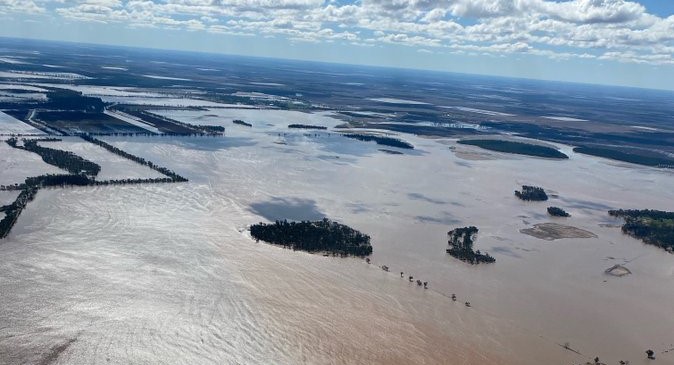Australia: Grain moving despite flood pressures

Supply chains are managing to push grain to export terminals, container packers and domestic consumers amid widespread flooding in the south-eastern Australian grainbelt.
This is despite most rail lines which carry grain within Victoria being closed due to flooding, and widespread road closures dotted from southern Queensland to central Victoria.
Stock Feed Manufacturers’ Council of Australia (SFMCA) executive officer Duncan Rowland said the organisation has worked to create a pathway for grain travelling on roads closed to general traffic because of flooding.
SFMCA has worked to create a contact point with state-based flood response teams for those wishing to carry feed inputs or finished feed on closed roads.
Applications must outline the proposed journey, and the reason for it.
“They’re looked at on a case-by-case basis; each road is inspected, and then a yay or nay is issued.”
Mr Rowland said co-operation among feed manufacturers is reducing the need for trucks to travel into flooded country.
It has seen competing companies service each other’s clients, or pick up from each other’s input suppliers, to minimise travel times and flood risk.
“One of the things I love about this industry is how they support each other; at the end of the day, they work together to make sure animals are being fed.”
With eastern Australia’s grainbelt sodden after successive rain since August, the flood situation, including rail and road closures, is changing daily as the La Niña weather event continues.
“We’ve got another 6-8 weeks of rain ahead of us; this is a long-term problem.”
In the 24 hours to 9am today, Moree received 108 millimetres of rain, ahead of Wee Waa on 69mm Gunnedah on 66mm.
It has closed the Newell Highway between Narrabri and the Queensland border, the Kamilaroi Highway on the Liverpool Plains, and the Gwydir Highway east of Moree.
The rain event could well delay the reopening of the Australian Rail Track Corporation (ARTC) Moree-Narrabri rail line scheduled to take place November 1.
The line is being upgraded as part of ARTC’s Inland Rail project.
“Due to continuing inclement weather in recent weeks right across NSW, construction works and site access on Inland Rail works has been severely limited,” an ARTC spokesperson said in a statement today.
“This has led to an impact on works on the Narrabri to North Star Phase 1 project.
“ARTC is working hard at every available opportunity to complete the possession as quickly as possible in line with the upcoming commencement of grain harvest season.
“We will provide an update on the situation when we are in a position to do so.”
The only operational rail line in NSW currently closed by flooding is at Grawlin south of Forbes, and expectations are high that the line between Narrabri and Walgett will close as floodwaters rise.
“Cotton is winding down, and grain hasn’t started yet, so the demand for freight is not great at the moment,” one trade source said.
The wet spring has crops running at least a fortnight behind normal, and many cereal crops in northern NSW which would normally be starting to ripen or close to harvest are still completely green.
It is buying the supply chain some time ahead of what is expected to be a wet and drawn-out harvest.
As eastern Australia’s biggest bulk handler by far, GrainCorp still has old-crop stocks to shift to port, and out-turn to domestic consumers.
“We’re working very hard to continue outloading from sites across our network in preparation for the upcoming harvest, but it’s certainly challenging given the frequently changing weather situation,” a GrainCorp spokesperson said.
“Our teams are doing a tremendous job preparing wet-weather alternatives for harvest activity, where possible, as well as meeting daily with local operations staff and planners to discuss site access and, where we can, move grain.
“Despite the challenges across the network, our teams are still outloading over 220,000 tonnes of grain each week.
“That’s roughly 80 per cent of our prior 12-week average, which is an incredible effort in difficult circumstances.”
GrainCorp said some sites are down on labour as staff defending their properties from floodwater.
“Our priority has been ensuring their safety; we’re supporting them fully and doing what we can to assist.
“We’re also continuing to work with all of our other staff and customers to ensure they are kept safe, and we appreciate the understanding from our customers and growers where this may impact movements.”
In a statement released on Tuesday, Victorian grower and GrainGrowers chair Brett Hosking said flooding in NSW and Victoria was causing havoc for growers in the lead-up to what was anticipated to be a bumper harvest.
“At a rough estimate, Australian growers were looking at potentially a 60-million-tonne crop this year,” Mr Hosking said.
“My estimation is approximately 20 million tonnes of production are in the cropping areas experiencing current weather events.”
“Presently, we don’t know what the damage will be.”
Mr Hosking said flood damage to infrastructure, particularly local roads, was of concern.
“Major supply routes are cut in half in many places and damaged roads in regional areas are a significant safety risk for communities.”
“We are keeping all our growers, their families, and communities in our thoughts.
“We want everyone to stay safe physically and we also acknowledge the toll on people’s mental health.
“The uncertainty and not knowing what to expect is difficult for growers and their families and we ask them to reach out if needed.”
Read also
Wheat in Southern Brazil Impacted by Dry Weather and Frosts
Oilseed Industry. Leaders and Strategies in the Times of a Great Change
Black Sea & Danube Region: Oilseed and Vegoil Markets Within Ongoing Transfor...
Serbia. The drought will cause extremely high losses for farmers this year
2023/24 Safrinha Corn in Brazil 91% Harvested
Write to us
Our manager will contact you soon



